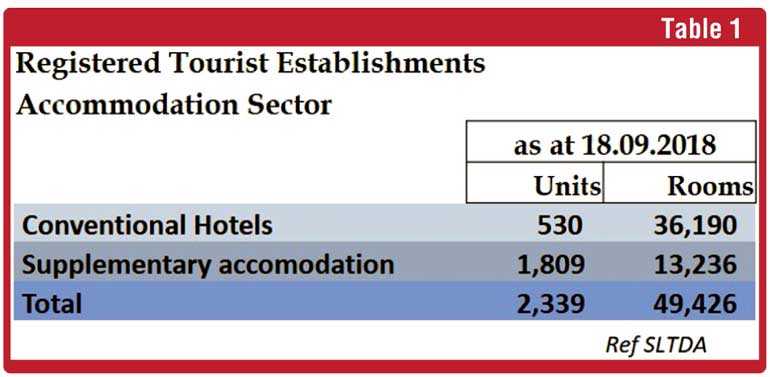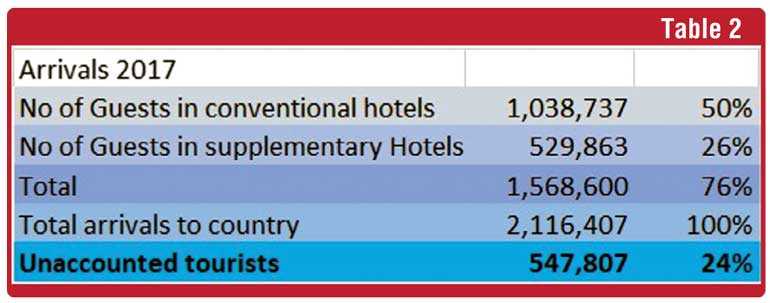Thursday Apr 25, 2024
Thursday Apr 25, 2024
Tuesday, 8 January 2019 00:00 - - {{hitsCtrl.values.hits}}


A few months ago the entire tourism and hospitality trade in particular, and the general population of Sri Lanka, were pleasantly surprised and proud that the tiny island of Sri Lanka had been rated as the best country to visit in 2019, by the Lonely Planet Publishers. It certainly augured well for the future of Sri Lanka Tourism, albeit with some of the euphoria souring a bit in the past few months due to the recent political ramifications. However with some form of ‘normalcy’ returning to the political scene tourism is expected to rebound quickly with only a possible ‘slow down’ in January 2019. Regardless of this there seems to be many sources trying to bask in the glory of this achievement claiming credit for it. Definitely many diverse aspects of tourism services and product offerings and policies, would have influenced the choice.
However it is worthwhile to study the real drivers and motivating factors that led to Lonely Planet making this decision.
Lonely Planet
Firstly let’s take a deeper look at the Lonely Planet Publication. Wikipedia refers to Lonely Planet as “a large travel guide book publisher… were the third series of travel books aimed at backpackers and other low-cost travellers, after the Let’s Go travel guide series that was founded in 1960. As of 2011, the company had sold 120 million books since inception and by early 2014, it had sold around 11 million units of its travel apps.
“The popularity of the hippy trail, combined with the success of the original Lonely Planet publications, led the founders Maureen and Tony Wheeler to further develop the brand they had founded.
“After several acquisitions of the company it still embraces its original ethos of ‘telling it like it is, without fear or favour’.”
A mention in a Lonely Planet guidebook can draw large numbers of travellers, which can even cause such a tourism influx that the destination itself can be affected. For example, Lonely Planet has been blamed for the rise of what is sometimes referred to as ‘The Banana Pancake Trail’ in South East Asia.
It is very clear that the Lonely Planet guide is a reliable, no frills, straight-talking guide book, which, while reviewing conventional products and services, also explores and reports on the smaller, less publicised, more rustic informal sector.
There is no doubt that millions of travellers all over the world, from all segments, high- end and low-end, rely on the Lonely planet guide.
However the main readership who make their travel decisions based on the Lonely Planet recommendations are predominantly the younger, more budget conscious, adventurous travellers who want to explore new sights ‘off the beaten track’.
So one could perhaps conclude that the popularity of Sri Lanka among the Lonely Planet readers was mainly influenced by the informal, rustic, mom-and pop operations.

The criteria for the choice
Apparently Lonely Planet choses its best destinations by feedback from its own writers and other associated traveller experiences.
Its website says “Lonely Planet’s staff collectively rack up hundreds of thousands of miles each year, exploring almost every destination on the planet in the process. Our annual Best in Travel survey is sent to the whole Lonely Planet family – every staff member, over 200 travel writers, bloggers, our publishing partners and more. They nominate destinations for the coming year; specifying why each place would be worth visiting based on current travel trends, upcoming events and attractions, and more… To finalise the list, a panel of in-house experts and travel influencers, including Lonely Planet co-founder Tony Wheeler, select the final ten in each category (countries, cities, regions and value) by giving each destination in the shortlist a score for topicality, excitement and ‘x-factor’.”
While the process seems fairly extensive there is no information available if they get any genuine customer feedback. So one has to conclude therefore that the main feedback was derived from like-minded people who are more attuned to the Lonely Planet ‘ethos’ of exploration of the off-the-beaten-track, less publicised, more rustic informal sector.
The website lists the 12 things you cannot miss when visiting Sri Lanka as:
1. Tea
2. Udawalawe National Park
3. Sigiriya
4. Wellness
5. Galle
6. Sinharaja
7. Beaches
8. Travel by rail
9. Anuradhapura
10. Kandy
11. Arugam Bay
12. Flavours and food

The informal tourism sector in Sri Lanka
The Sri Lankan Tourism accommodation sector can be classified into three categories as follows:
See table 1 for statistics from the SLTDA in September 2018 on accommodation sector composition.
There are no reliable statistics of the real informal accommodation sector which comprises the large number of home stays and AirBnB units, most of which are not registered with the SLTDA. However there are reasonably accurate foreign guest nights recorded at all registered establishments and available with the SLTDA.
Given that the average length of stay of a tourist is 10 days, with some simple arithmetic one can calculate the actual number of tourists who patronised these sectors. When these figures are compared with the overall arrivals to the country there is found to be a significance variance or unaccounted number of tourists
Hence one can postulate that a large number of this unaccounted 547,807 (24%) would be those who are patronising the real informal unregistered sector. There could of course be a few of diaspora who carry foreign passports and do not stay in paid accommodation within this number, but it is insignificant
The main part of this ‘leakage’ are the tourists who stay in real unregistered informal sector. These are the large number of un-registered small ‘bed and breakfast’ units that have sprung up in all popular tourist cities on the ‘round trip circuit’, whose statistics are not caught up in the SLTDA records.
Hence the bottom line is that the informal, unregulated sector is accounting for about one in four tourists who visit the country.
If the supplementary sector (which is the smaller registered players) is also taken into the equation, it is clear that the conventional hotels are only getting about 50% of all arrivals.
This indicates that whatever said and done, the informal sector (regulated or otherwise) is playing a major part as a part of Sri Lanka’s tourism portfolio
Informal sector – good or bad?
There is a strong perception that the informal sector is slowly ‘sucking the life blood’ out of the tourism market in Sri Lanka, and possibly having some detrimental effects to the overall real growth of Tourism to the country.
The lament of the formal operators is that these smaller units operate outside the proper legal framework, without conforming to all regulations and without paying proper taxes to the state. There certainly could be some truth in this, where currently with the service charge (S/C) that is levied by the formal sector, a good 31% of the top line revenue is reduced due to S/C and taxes.
This means that for every $ 100 that is charged by the formal sector, the effective net revenue to the institution is only about $ 69. Many of the informal establishments which operate outside the jurisdiction of the SLTDA pay these levies and thus have an immediate price advantage.
However the other side of the coin is that these smaller operators are providing an exciting, rustic, authentic, value for money and more experiential product offering, which seems to be one of the main drivers of Sri Lanka tourism currently.
So before we attempt to ‘wave the big sword’ and regulate this sector one must be cautious that the very essence of creativity and excitement that is provided by this sector is not stifled in the process.
Conclusions